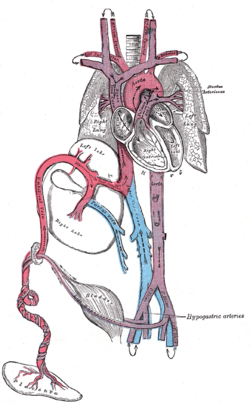| Umbilical vein | |
|---|---|
 Fetal circulation; the umbilical vein is the large, red vessel at the far left. | |
 Human embryo. Brain and heart represented from right side. Digestive tube and yolk sac in median section. (Umbilical vein labeled at bottom left.) | |
| Details | |
| Drains to | Inferior vena cava |
| Artery | Umbilical artery |
| Identifiers | |
| Latin | vena umbilicalis |
| MeSH | D014471 |
| TA98 | A12.3.12.010 |
| TA2 | 5103 |
| FMA | 70317 |
| Anatomical terminology | |
The umbilical vein is a vein present during fetal development that carries oxygenated blood from the placenta into the growing fetus. The umbilical vein provides convenient access to the central circulation of a neonate for restoration of blood volume and for administration of glucose and drugs.[1]
The blood pressure inside the umbilical vein is approximately 20 mmHg.[2]